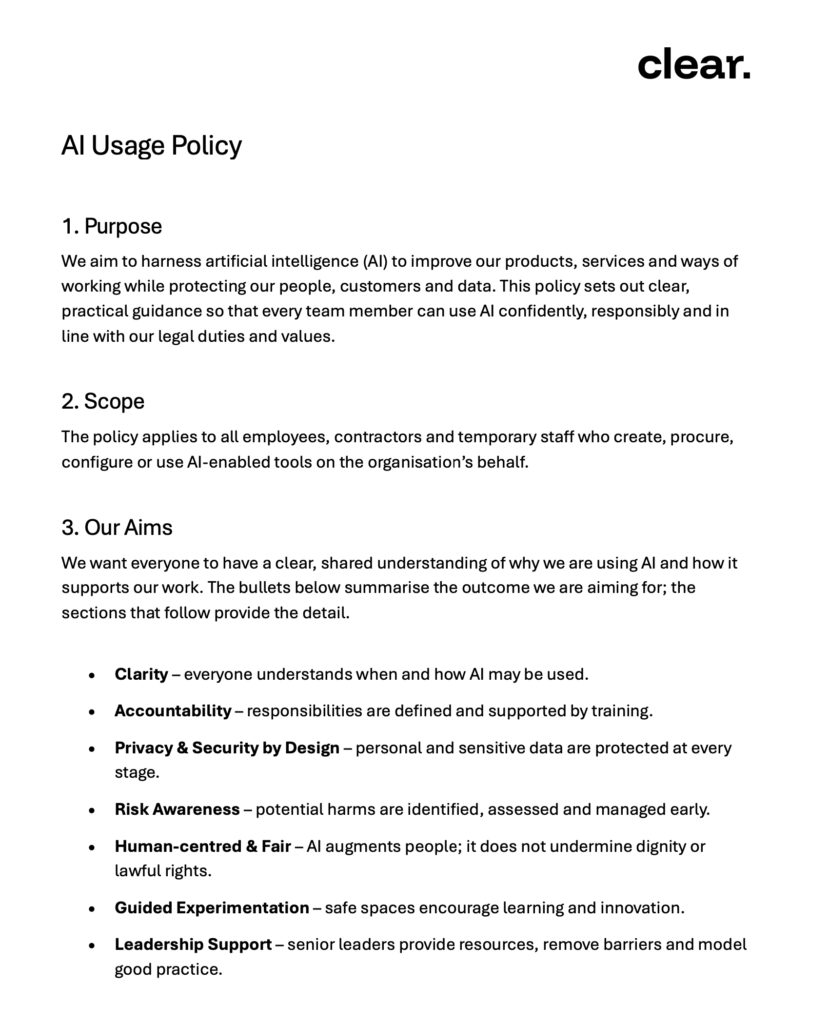Defining AI Management Systems
An AI Management System (AIMS) is a comprehensive platform designed to help organisations systematically plan, deploy, monitor, and govern their artificial intelligence initiatives. Unlike individual AI tools or applications, an AIMS such as Clear provides the framework and infrastructure needed to manage AI adoption at an organisational level.
Think of it as the central nervous system for your company’s AI strategy—connecting different AI initiatives, ensuring they align with business objectives, and providing the oversight needed to maximise value while minimising risk.
The Challenge AIMS Addresses
As artificial intelligence becomes increasingly integrated into business operations, organisations face a growing challenge: how to harness AI’s transformative potential while maintaining control, compliance, and strategic alignment. This is where AI Management Systems (AIMS) come into play.
Many organisations find themselves in one of two problematic situations with AI:
The Wild West Approach: Teams across the organisation are experimenting with various AI tools without coordination, leading to:
- Inconsistent data practices
- Compliance gaps
- Duplicated efforts
- Unclear ROI measurement
- Security vulnerabilities
The Paralysis Trap: Organisations become so overwhelmed by the complexity and risks of AI that they delay implementation, falling behind competitors who are already gaining advantages from AI adoption.
AIMS bridges this gap by providing structure without stifling innovation.
Core Components of an AIMS
1. Governance Framework
- Policy Management: Centralised creation and distribution of AI usage policies
- Compliance Monitoring: Tools to ensure adherence to regulations like GDPR, industry standards, and internal guidelines
- Risk Assessment: Systematic evaluation of AI initiatives for potential risks and mitigation strategies
2. Innovation Platform
- Idea Management: Structured process for capturing, evaluating, and prioritising AI opportunities
- Pilot Programs: Framework for testing AI solutions in controlled environments
- Knowledge Sharing: Platforms for teams to share learnings and best practices
3. Resource Management
- Budget Tracking: Monitoring AI-related expenditures across departments
- Talent Allocation: Identifying skill gaps and managing AI expertise across the organisation
- Technology Inventory: Catalogue of AI tools and platforms in use
4. Performance Measurement
- ROI Tracking: Quantifying the business impact of AI investments
- Success Metrics: Defining and monitoring KPIs for AI initiatives
- Reporting Dashboards: Executive-level visibility into AI program performance
Benefits of Implementing an AIMS
Strategic Alignment
AIMS ensures that AI initiatives support broader business objectives rather than existing in isolation. This alignment helps prioritise investments and ensures resources are directed toward high-impact opportunities.
Risk Mitigation
By providing centralised oversight, AIMS helps organisations identify and address potential risks before they become problems. This includes everything from data privacy concerns to algorithmic bias.
Accelerated Innovation
Rather than slowing down AI adoption, a well-designed AIMS actually accelerates innovation by providing clear guidelines, shared resources, and proven frameworks that teams can build upon.
Improved ROI
Systematic tracking and optimisation of AI investments typically leads to better returns. AIMS helps organisations identify what’s working, what isn’t, and where to focus future investments.
Competitive Advantage
Organisations with mature AI management capabilities can move faster and more confidently than competitors who are still figuring out their AI strategy.
Who Needs an AIMS?
While any organisation using AI can benefit from better management, AIMS is particularly valuable for:
- Mid-sized companies (20-250 employees) that have outgrown ad-hoc AI adoption but lack enterprise-level AI governance infrastructure
- Regulated industries where compliance requirements make structured AI management essential
- Organisations with multiple departments using AI tools independently
- Companies planning significant AI investments and needing to ensure maximum value
Implementation Considerations
Start with Foundation
The starting point when using an AI Management System will be defining:
- Clear AI vision and objectives
- Basic governance policies
- Stakeholder buy-in from leadership
- Assessment of current AI usage
Choose the Right Platform
AIMS solutions range from comprehensive platforms to specialised tools. Consider factors like:
- Organisation size and complexity
- Budget constraints
- Integration requirements
- Level of expert support needed
The most effective AIMS platforms offer transparent pricing with comprehensive feature sets, making them accessible for mid-market companies without the complexity of enterprise solutions.
Focus on Adoption
The most sophisticated AIMS is worthless if teams don’t use it. Success depends on:
- User-friendly interfaces
- Clear value proposition for end users
- Adequate training and support
- Integration with existing workflows
The Path to ISO 42001 Compliance
For organisations considering ISO 42001 certification, implementing a practical AIMS platform serves as an essential stepping stone. ISO 42001 requires organisations to demonstrate systematic approaches to AI governance, risk management, and continuous improvement—exactly what modern AIMS platforms are designed to facilitate.
The standard demands documented processes for:
- AI policy development and implementation
- Risk assessment and management procedures
- Stakeholder engagement and communication
- Performance monitoring and evaluation
- Incident management and corrective actions
A well-designed AIMS platform provides the infrastructure to not only meet these requirements but to operationalise them effectively. Rather than maintaining compliance through manual processes and spreadsheets, organisations can use their AIMS to automatically generate audit trails, track policy adherence, and demonstrate continuous improvement.
This means that implementing an AIMS isn’t just about immediate operational benefits—it’s also an investment in future compliance readiness. Organisations that establish robust AI management practices today will find the path to ISO 42001 certification significantly smoother when they’re ready to pursue it.
The Future of AI Management
As AI becomes more pervasive and regulations more stringent, AIMS will likely become as essential as traditional IT management systems. The growing adoption of standards like ISO 42001 signals that systematic AI management is transitioning from a competitive advantage to a business necessity.
Organisations that establish mature AI management capabilities early will be better positioned to capitalise on future AI developments while maintaining trust and compliance. They’ll also find themselves ahead of the curve when industry standards or regulatory requirements make formal AI management systems mandatory.
Conclusion
An AI Management System such as Clear creates the conditions for AI to thrive within your organisation. By providing structure, governance, and strategic alignment, AIMS enables organisations to pursue AI innovation with confidence.
The question isn’t whether your organisation needs better AI management, but rather how quickly you can implement the systems and processes needed to turn AI from a collection of isolated experiments into a genuine competitive advantage.
For organisations ready to move beyond ad-hoc AI adoption, implementing an AIMS represents a crucial step toward building a sustainable, scalable, and successful AI strategy. It’s also an investment in future compliance readiness, whether that’s meeting emerging regulatory requirements or pursuing formal certification under standards like ISO 42001.


